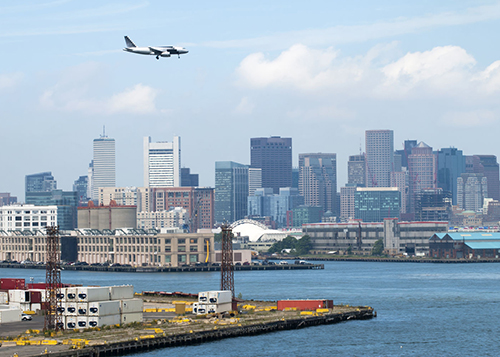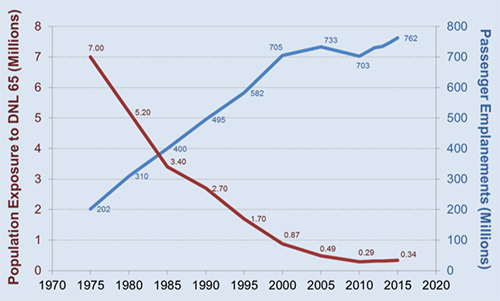Reducing Aviation Noise, Advancing the Aviation Enterprise
Noise and neighborhoods don’t mix. Research shows that excessive noise can affect children’s cognitive performance, disturbs sleep, and is likely associated with increased risk of cardiovascular disease.
Transportation is one leading cause of noise, and aircraft in particular can cause high levels of noise.
Earlier this year, the National Academy of Engineering (NAE), in cooperation with the Institute of Noise Control Engineering, the Federal Aviation Administration (FAA), and NASA—hosted a workshop with leaders from government, academia, and aviation industry groups, including Gregg Fleming, director of Policy, Planning, and Environment at the U.S. DOT Volpe Center.

“Aircraft manufacturers, airlines, and aviation authorities in the U.S. are interested in reducing aviation noise by investigating new ways to reduce noise levels,” Fleming said. “There’s a focus on how aircraft design, operations, and land-use planning can reduce aviation noise.” (Bruzas/123RF photo)
The workshop committee recently released a summary report from the workshop with recommendations on reducing aircraft noise, along with a recently released comprehensive report.
Experts at the workshop found that although aircraft are substantially less noisy than they were several decades ago, current levels of U.S. investment in aircraft technology are insufficient. They agreed that without sharp investment increases in more environmentally compatible technologies and strategies, America’s role as a global aviation leader is at risk.
Embracing a P3 Approach
NASA and FAA use a public-private partnership (P3) approach with the U.S. aviation industry to advance aircraft technology, including technologies that reduce noise. By 2020, FAA will have invested roughly $225 million in its Continuous Lower Energy, Emissions, and Noise program, which aims to develop technologies that will reduce noise, emissions, and fuel burn.
This program has a 50/50 industry cost share, bringing the total investment to $450 million over 10 years.
“The P3 approach is essential to industry, and it can lead to very effective technologies that can reduce noise for communities near airports,” Fleming said. “With P3, the government and private industry share risk in order to achieve gains that benefit both the public and private sectors. Still, the NAE-hosted workshop found that those investment levels are currently too low.”
The Economic Imperative to Reduce Aircraft Noise
Since 1975, the U.S. population exposed to a day-night average sound level of 65 decibels or higher has been reduced by 95 percent, even with a concurrent 260 percent increase in passengers traveling in the U.S.

The U.S. population exposed to high noise levels has been reduced sharply over the past forty years, despite a steep rise in passenger travel.
Despite gains in noise reduction, community noise is still a constraint on an industry that plays an outsized role in the U.S. economy. Commercial aviation manufacturing is the top U.S. net export, generating a positive trade balance of $59.9 billion in 2014. That year, commercial aviation overall generated $1.6 trillion in economic activity and accounted for 5.1 percent of gross domestic product.
“Aircraft manufacturers, airlines, and aviation authorities in the U.S. are interested in reducing aviation noise by investigating new ways to reduce noise levels,” Fleming said. “There’s a focus on how aircraft design, operations, and land-use planning can reduce aviation noise.”
Reducing Noise Through Better Aircraft Design
Experts at the NAE-hosted workshop agreed that a paradigm shift from the traditional tube-and-wing aircraft design is needed to achieve continued substantial noise reductions.
In looking toward technological improvements that can reduce noise, aviation industry stakeholders are working to understand how noise and fuel burn are linked. In addition to evidence linking excessive noise and potential health impacts, fuel burn represents roughly one-third of airline operating costs.
Technologies that reduce fuel burn can also improve aircraft noise. For example, the introduction of the high-bypass ratio turbofan in the 1970s was aimed at reducing fuel burn but also led to significant reductions in noise. More recently, the geared turbofan—developed by industry in collaboration with NASA—is poised to significantly reduce fuel burn and noise.
Tomorrow’s Technology, Today’s Noise Reduction Strategies
Technology investment is critical to reducing aviation noise, but it can take years for new designs to significantly extend across the commercial operating fleet.
Other strategies for reducing noise can lead to more immediate noise reductions. These strategies typically follow the Balanced Approach to Aircraft Noise Management in conjunction with other policies and best practices established by the International Civil Aviation Organization, including land-use planning, operational procedures, restrictions, and community engagement, in addition to source noise reduction.
For example, the federal government has provided more than $10 billion for insulating homes and schools nears airports over the past 35 years.
Performance-Based navigation (PBN) is another strategy that can help reduce aviation noise. PBN couples satellite technology with advanced avionics to create precise 3-D flight paths. To reduce noise, airports use PBN in an effort to route aircraft to minimize population impact.
But, strategies can have unintended consequences that flight planners should be aware of. With PBN, a neighborhood beneath a PBN corridor may experience increased, sustained aviation noise, while numerous other communities previously under flight paths may experience greatly reduced noise.
Read the summary NAE-hosted workshop report and the comprehensive report: Commercial Aviation: A New Era for the U.S. Economy and Global Prestige.
